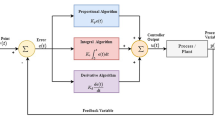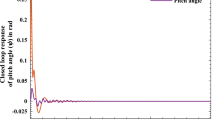Abstract
In this paper, a design method of decentralized proportional–integral–derivative (PID) controller for two-input two-output processes based on pre-defined reference transfer function is proposed. An ideal decoupler is used to reduce the interaction among system variables. Free structure higher order diagonal controllers are computed for each decoupled subsystem by specifying closed-loop response in terms of dominant reference second order transfer function. Further, to obtain controllers in PID structure, the higher order diagonal controllers are truncated into first three terms of Maclaurin series. The stability of resulting PID controller is investigated. Two benchmark examples are illustrated to show the effectiveness of the proposed controller. An experimentation is performed on interacting coupled tank process to demonstrate the applicability in real life applications.

















Similar content being viewed by others
References
Kumar VV, Rao VSR, Chidambaram M (2012) Centralized PI controllers for interacting multivariable processes by synthesis method. ISA Trans 51(3):400–409
Luan X, Chen Q, Liu F (2014) Centralized PI control for high dimensional multivariable systems based on equivalent transfer function. ISA Trans 53(4):1554–1561
Wang QG, Huang B, Guo X (2000) Auto-tuning of TITO decoupling controllers from step tests. ISA Trans 39(4):407–418
Luyben WL (1986) Simple method for tuning SISO controllers in multivariable systems. Ind Eng Chem Process Des Dev 25(3):654–660
Xiong Q, Cai WJ (2006) Effective transfer function method for decentralized control system design of multi-input multi-output processes. J Process Control 16(8):773–784
Chiu MS, Arkun Y (1992) A methodology for sequential design of robust decentralized control systems. Automatica 28:997–1001
Mayne DQ (1973) The design of linear multivariable systems. Automatica 9:201–207
Shiu SJ, Hwang SH (1998) Sequential design method for multivariable decoupling and multiloop PID controllers. Ind Eng Chem Res 37(1):107–119
Grosdidier P, Morari M (1986) Interaction measures for systems under decentralized control. Automatica 22:309–319
Hovd M, Skogestad S (1993) Improved independent design of robust decentralized controllers. J Process Control 3(1):43–51
Ziegler JG, Nichols NB (1942) Optimum settings for automatic controllers. ASME Trans 64:759–768
Chien IL, Huang HP, Yang JC (1999) A simple multiloop tuning method for PID controllers with no proportional kick. Ind Eng Chem Res 38:1456–1468
Lee J, Edgar TF (2006) Multiloop PI/PID control system improvement via adjusting the dominant pole or peak amplitude ratio. Chem Eng Sci 61:1658–1666
Zhang Y, Wang QG, Astrom KJ (2002) Dominant pole placement for multi-loop control systems. Automatica 38(7):1213–1220
Ho WK, Lee TH, Xu W, Zhou JR, Tay EB (2000) The direct Nyquist array design of PID controllers. IEEE Trans Ind Electron 47(1):175–185
Gilbert AF, Yousef A, Natarajan K, Deighton S (2002) Tuning of PI controllers with one-way decoupling in \(2\times 2\) MIMO systems based on finite frequency response data. J Process Control 13(6):553–567
Tavakoli S, Griffin I, Fleming PJ (2006) Tuning of decentralised PI(PID) controllers for TITO processes. Control Eng Pract 14(9):1069–1080
Shen Y, Li S, Li N, Cai WJ (2011) Partial decoupling control for multivariable processes. Ind Eng Chem Res 50(12):7380–7387
Rajapandiyan C, Chidambaram M (2012) Controller design for MIMO processes based on simple decoupled equivalent transfer functions and simplified decoupler. Ind Eng Chem Res 51:12398–12410
Nordfeldt P, Hagglund T (2006) Decoupler and PID controller design of TITO systems. J Process Control 16:923–936
Jevtovic BT, Matausek MR (2010) PID controller design of TITO system based on ideal decoupler. J Process Control 20(7):869–876
Maghade DK, Patre BM (2012) Decentralized PI/PID controllers based on gain and phase margin specifications for TITO processes. ISA Trans 51(4):550–558
Le BN, Wang QG, Lee TH (2014) A graphical approach to computing loop gain margins for tito systems. Trans Inst Meas Control 36(5):600–603
Maghade DK, Patre BM (2014) Pole placement by PID controllers to achieve time domain specifications for TITO systems. Trans Inst Meas Control 36:506–522
Garrido J, Vazquez F, Morilla F (2014) Inverted decoupling internal model control for square stable multivariable time delay systems. J Process Control 24(11):1710–1719
Garrido J, Vazquez F, Morilla F (2013) Centralized inverted decoupling control. Ind Eng Chem Res 52(23):7854–7866
Chen D, Seborg DE (2003) Design of decentralized PI control system based on Nyquist stability analysis. J Process Control 13(1):27–39
Jin QB, Liu Q (2014) Decoupling proportional–integral–derivative controller design for multivariable processes with time delays. Ind Eng Chem Res 53(2):765–777
Sebor DE, Edger TF, Mellichamp DA (2004) Process dynamics and control, 2nd edn. Wiley, New York
Skogestad S, Postletwaite I (1996) Multivariable feedback control: analysis and design, 2nd edn. Wiley, New York
Wood RK, Berry MW (1973) Terminal composition control of a binary distillation column. Chem Eng Sci 28(9):1707–1717
Shen Y, Sun Y, Li S (2012) Adjoint transfer matrix based decoupling control for multivariable processes. Ind Eng Chem Res 51(50):16419–16426
Xiong Q, Cai WJ, He MJ (2007) Equivalent transfer function method for PI/PID controller design of MIMO processes. J Process Control 17:665–673
Author information
Authors and Affiliations
Corresponding author
Rights and permissions
About this article
Cite this article
Hajare, V.D., Patre, B.M., Khandekar, A.A. et al. Decentralized PID controller design for TITO processes with experimental validation. Int. J. Dynam. Control 5, 583–595 (2017). https://doi.org/10.1007/s40435-016-0252-z
Received:
Revised:
Accepted:
Published:
Issue Date:
DOI: https://doi.org/10.1007/s40435-016-0252-z




